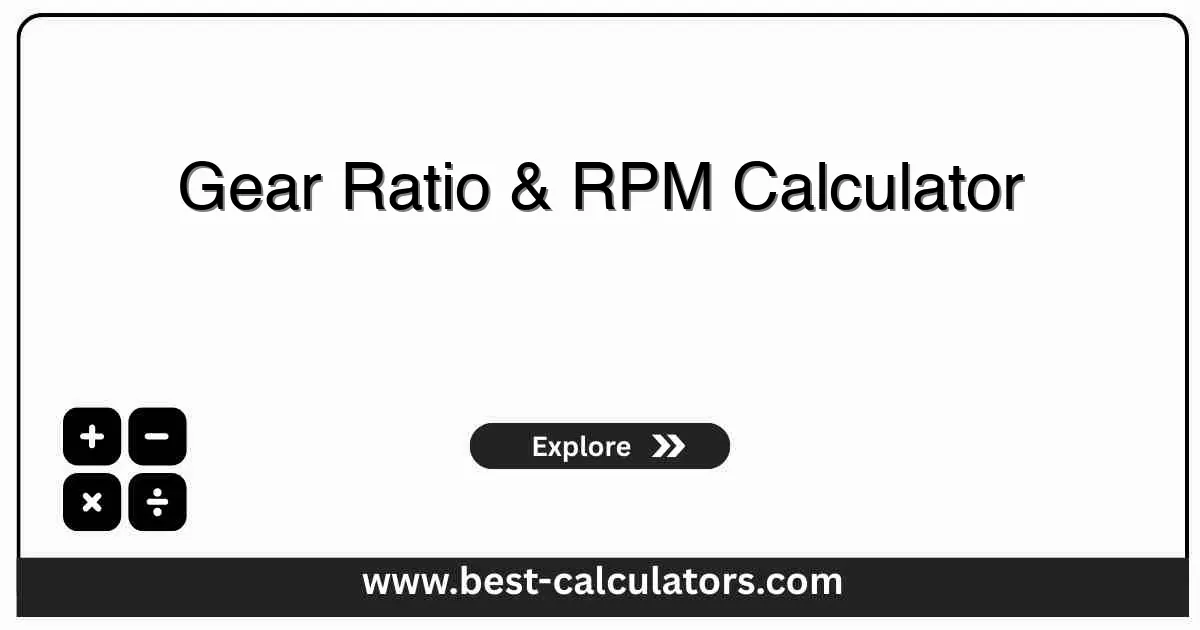Gear Ratio & RPM Calculator - Calculate Speed Reduction & Mechanical Advantage
Calculate gear ratios, output RPM, mechanical advantage, and velocity ratio for gear systems
Gear Ratio & RPM Calculator
Results
Note: Ratio > 1 indicates speed reduction.
What is a Gear Ratio & RPM Calculator?
A Gear Ratio & RPM Calculator is a free mechanical engineering tool that calculates the relationship between input and output speeds in gear systems. The gear ratio (GR) determines how rotational speed and torque are transferred between driver and driven gears, essential for power transmission design.
This calculator is essential for:
- Mechanical Design - Designing gear trains for optimal speed and torque transfer
- Automotive Engineering - Analyzing transmission ratios and drivetrain performance
- Robotics - Selecting appropriate gear ratios for motor speed reduction
- Engineering Education - Learning power transmission and machine design principles
For rotational power analysis, try our Torque, Power & Speed Calculator.
For spring mechanics, use our Spring Constant & Deflection Calculator.
How Gear Ratio is Calculated
The calculation uses fundamental gear ratio formulas:
Where:
- GR = Gear ratio (dimensionless)
- N_driven = Number of teeth on driven gear
- N_driver = Number of teeth on driver gear
- D_driven = Diameter of driven gear
- D_driver = Diameter of driver gear
Output RPM is calculated as:
Mechanical advantage equals the gear ratio, while velocity ratio is the inverse. Speed reduction occurs when GR > 1, and speed increase when GR < 1.
Key Gear Mechanics Concepts
Gear Ratio
The ratio of driven to driver gear sizes. Determines speed and torque conversion in gear systems.
Speed Reduction
When GR > 1, output speed decreases while torque increases proportionally. Used in high-torque applications.
Mechanical Advantage
Torque multiplication factor equal to gear ratio. Higher ratio means more torque but lower speed.
Velocity Ratio
Ratio of input to output speed, equal to 1/GR. Represents speed conversion efficiency.
How to Use This Calculator
- Enter Input RPM: Input the rotational speed of the driver gear in revolutions per minute
- Select Calculation Method: Choose between number of teeth or diameter measurement
- Enter Driver Gear Value: Input the number of teeth or diameter of the driver (input) gear
- Enter Driven Gear Value: Input the number of teeth or diameter of the driven (output) gear
- Calculate: Click "Calculate Gear Ratio" to compute all gear parameters
- Review Results: Check gear ratio, output RPM, mechanical advantage, and speed change type
Example:
Driver gear: 20 teeth, Driven gear: 60 teeth, Input: 1000 RPM
GR = 60/20 = 3:1, Output = 1000/3 = 333.33 RPM (Speed Reduction)
Benefits of Using This Calculator
- Instant Results: Calculate gear ratios and output speeds in seconds
- Multiple Methods: Calculate by teeth count or diameter measurements
- Comprehensive Analysis: Get mechanical advantage, velocity ratio, and speed change
- Speed Classification: Automatically identifies speed reduction or increase
- Engineering Accuracy: Uses standard gear ratio formulas from machine design
- Educational Tool: Perfect for learning power transmission principles
- Professional Use: Suitable for engineers, designers, and technicians
Factors Affecting Gear Performance
- Gear Ratio: Determines speed-torque tradeoff in power transmission systems
- Number of Teeth: More teeth provide smoother operation and higher contact ratio
- Gear Efficiency: Friction losses reduce actual output speed and torque (typically 95-99%)
- Gear Type: Spur, helical, bevel, and worm gears have different efficiency characteristics
- Load Conditions: Heavy loads may require lower speeds and higher torque (higher GR)
- Compound Gearing: Multiple gear stages multiply overall gear ratio
- Material Selection: Gear materials affect strength, wear resistance, and efficiency

Frequently Asked Questions (FAQ)
What is gear ratio?
Gear ratio is the relationship between the number of teeth (or diameter) of two meshing gears. It determines how rotational speed and torque are transferred from the driver gear to the driven gear. A ratio greater than 1 indicates speed reduction, while less than 1 indicates speed increase.
How is gear ratio calculated?
Gear ratio is calculated using the formula: GR = N_driven / N_driver or GR = D_driven / D_driver, where N is the number of teeth and D is the diameter. Output RPM is calculated as: RPM_out = RPM_in / GR.
What is mechanical advantage in gears?
Mechanical advantage in gears is the ratio by which torque is multiplied. It equals the gear ratio. A gear ratio of 3:1 provides a mechanical advantage of 3, meaning the output torque is 3 times the input torque, while speed is reduced by the same factor.
What is the difference between speed reduction and speed increase?
Speed reduction (gear ratio > 1) occurs when a smaller driver gear drives a larger driven gear, reducing output RPM but increasing torque. Speed increase (gear ratio < 1) occurs when a larger driver gear drives a smaller driven gear, increasing output RPM but decreasing torque.